The recent Galwan valley incident as well as the earlier attack at Pulwama and the airstrikes on Balakot in Pakistan, as expected, generated great deliberation and debate on every news channels, which was closely followed by the entire nation. Monitoring the debates, I could not but observe the deep divide in the thought process between the military experts and the other participants in dealing with the issues at stake. The military experts were senior officers from the services – retired Generals, Air Marshals and Admirals; while the other participants in the debate were from diverse fields as academia, politicians, diplomats, lawyers, etc. The common thread of reasoning which was held by most military experts was binary and aimed to provide simplistic military solutions to complex problems. This got me thinking as to why we have a narrow worldview. This may have its roots deeply intertwined in the way we in the military are conditioned or programmed to think.
The impact of behavioural psychology in the field of combat and military training has been the subject of many studies abroad in the second half of the 20th century and has brought many revolutionary changes in training. The ability of behavioural psychology to turn voluntary motor responses into a conditioned response was first demonstrated by JB Watson[1] in an experiment, which studied maze-learning, using rats in a type of maze that was simply a long, straight alley with food at the end. Watson found that once the animal was well trained at running this maze it did so almost automatically, or reflexively. Some of these concepts or its variations have been used in the training process in the military training institutes.
The conditioning process starts with the selection of officers at the SSB, where personnel with the right amalgamation of the fifteen Officer Like Qualities (OLQs) are selected so that the attitudes and behaviour can be conditioned to think in a desired way so that the outcomes are consistent with the expectations. After the selection, the officers are put through a rigorous initial training programme, which depending on the type of entry could range between six months to three years. The initial military training is an intensive residential programme, which aims to induct the newly recruited personnel into the social norms and essential tasks of the armed forces and are mostly focussed on drills, inspections, physical training, weapons training with the academic curriculum running in parallel. After the initial training, the officers are put through regular training programmes through their career, which constantly endeavours to reinforce these attitudes and behaviours.
It is important to understand that the officers are put through a training programme, which is quite distinct from an education programme, which one goes through in college. While it may be argued that the two are synonymous, as we frequently use them interchangeably, they are not the same, there is a significant denotative difference. While training is more concerned with teaching what to think and what the answers ought to be, education is all about teaching how to think and what the questions ought to be. Training is focused on the development and performance of specific tasks or skills, and education is oriented toward more generalized and abstract knowledge that may or may not be tied to specific tasks or activities. In this case, the training is used to prepare an individual or an organization to execute specified tasks. Finally, it is normally the preferred method of learning when the goal is to perform operations in which success, failure, and completion can be clearly measured. Education has more to do with how to think about problems and how to deal with those things that may not lend themselves to categorical solutions.
Psychological conditioning techniques are extensively used to shape attitudes and behaviours and rendering them to conform to the requirements of the military. The four types of psychological conditioning techniques are role modelling, classical conditioning, operant conditioning, and brutalization[2].
The ones of interest are classical and operant conditioning, which play a major role in shaping the behaviour of officers. Classical conditioning (also known as Pavlovian conditioning[3]) refers to a learning procedure in which a biologically potent stimulus (e.g. food) is paired with a previously neutral stimulus (e.g. a bell). It also refers to the learning process that results from this pairing, through which the neutral stimulus comes to elicit a response (e.g. salivation) that is usually similar to the one elicited by the potent stimulus. This technique was used by the Japanese with their soldiers. Early in World War II, Chinese prisoners were placed in a ditch on their knees with their hands bound behind them. A select few Japanese soldiers would go into the ditch and bayonet “their” prisoner to death, a horrific way to kill another human being. Upon the bank, countless other young soldiers would cheer them on in their violence. Immediately afterwards, the soldiers who had been spectators were treated to sake (Japanese wine), a sumptuous meal and so-called comfort girls. The end result was the association of committing violent acts with pleasure. Comparatively few soldiers actually killed in these situations, but by making the others watch and cheer, the Japanese were able to use these kinds of atrocities to classically condition a very large audience to associate pleasure with human death and suffering.
A typical example of classical conditioning which we can relate to easily in the navy is career progression. Every officer has a desire for career progression and to do so you need to be promoted. In order to receive a promotion in the navy, you have to meet certain guidelines such as ACR merit, Pass Staff College and Command exam, medical and physical fitness, etc. Now the desire for career progression is the unconditioned stimulus (UCS). ACR merit, exams, fitness etc are the neutral stimulus (NS). Which leaves promotion as the unconditioned response (UCR). Now every time an officer is considered for promotion he will be evaluated and told if they meet the requirement by looking at the NS. Over time, the conditioned response will result in the officer striving to improve his ACR rating, maintaining physical fitness and doing mandatory courses in order to be promoted. Now, this is not as cut and dry as Pavlov research, but this is an example to relate classical conditioning in a naval setting.
Operant conditioning is a more widely used style of learning that the military uses when training soldiers. Operant conditioning is a learning process through which the strength of a behaviour is modified by reinforcement or punishment. In operant conditioning, stimuli present when a behaviour is rewarded or punished come to control that behaviour. A benign example is the use of flight simulators to train pilots. A pilot in training flies a flight simulator for endless hours; when a particular warning light goes on, he is taught to react in a certain way. When another warning light goes on, a different reaction is required. It is Stimulus-response, stimulus-response, stimulus-response. In an actual emergency, the response is invariably correct, as the pilot has been conditioned to respond reflexively to this particular crisis.
Although operant and classical conditioning both involve behaviours controlled by environmental stimuli, they differ in nature. In classical conditioning, a neutral stimulus becomes associated with an involuntary response, such as salivation or increased heart rate. But operant conditioning involves voluntary actions (such as aiming and firing a weapon) with reinforcing or punishing events serving to alter the strength of association between the stimulus and the response.
The process, which starts during the initial training, is constantly reinforced through the career of the officer. The reinforcement is an important aspect, as it would otherwise lead to extinction or disappearance of a previously learned behaviour when the behaviour is not reinforced. After the initial training, the officer proceeds for obtaining his watching keeping certificate, where he is drilled to react in a certain way, an expected response to a particular stimulus. Responses, which are not in conformity, are punished while those conforming are rewarded. So often we hear “Don’t think, just do what I say”. The officer like the pigeon in the Skinner box[4] learns that each time he does what he is told he is rewarded, which may in the form of liberty ashore, praise, etc or when he fails to do the job has a punishment with stoppage of liberty. This process is continued during his subsequent appointments, where his seniors and his commanding officers continue the conditioning process. Those in power have always attempted to utilize the basic behavioural concepts of rewards, punishments, and repetitive training to shape or control, and in many cases, they would hope, predict the responses of personnel.
Another example of operant conditioning, which we can easily relate to, is keeping a watch at sea. Maintaining a sharp lookout and visually picking up contacts and evaluating them is an important facet of watchkeeping. The stimulus is the target ship, which is to be visually detected. The response or target behaviour, which needs to be conditioned, is to visually detect the ship early at an appropriate range. The feedback is a reward in the form of appreciation or punishment by way of reprimand or extra duty. The Commanding Officer ensures that the target behaviour is consistent by an application of operant conditioning.
An application of Operant conditioning is in improving modern military marksmanship training. The change in the training pattern was based on the study carried out by Brigadier General S.L.A. Marshall (Chief Historian of the European Theatre of Operations in World War II), who concluded in his landmark book, Men Against Fire, that only 15 to 20% of the individual riflemen in World War II fired their weapons at an exposed enemy soldier. The Human Resources Research Office of the US Army subsequently pioneered a revolution in combat training that replaced the old method of firing at the bull’s-eye targets with deeply ingrained operant conditioning using realistic, man-shaped pop-up targets that fall when hit.
The operant response being conditioned is to accurately fire a weapon at a human being or at least a realistic simulation of one. The firer and the grader know if the firing is accurate since the target drops when hit. This realistically simulates what will happen in combat, and it is gratifying and rewarding to the firer. This minimal gap between the performance (hitting the target) and the initial reinforcement (target drops) is key to successful conditioning since it provides an immediate association between the two events. A form of the token economy is established as an accumulation of small achievements (hits) are cashed in for marksmanship badges and other associated rewards (such as a three-day pass), and punishments (such as having to retrain on a Saturday that would have otherwise been a day off) are presented to those who fail to perform. The application and perfection of these basic conditioning techniques appear to have increased the rate of fire from near 20% in World War II to approximately 55% in Korea and around 95% in Vietnam.
At every stage in the career of an officer, the process of operant conditioning is subtly applied to ensure the response to a stimulus is consistent so that the outcomes are within the bounds of expectation. Another example of the impact of operant conditioning can be gleaned from a survey of the numerous “appreciations” or “commander’s intent” written during the tactical exercises conducted at MWC. The narratives and settings for the exercise are confined to a narrow band with the intention of conditioning thinking out solutions along expected lines. The games are run and situations injected so that doctrine driven solutions are practised, which result in predictable outcomes and reinforce the tactical thought process. The use of standard templates for the appreciation leads to the astringent thought process, which combined with a heavy reliance on doctrine leads to predictable outcomes. The response of an individual may vary from moment to moment, in such aspects as the specific motions involved, the amount of force applied, or the timing of the response. However, variations in thought process are conditioned through negative reinforcement by chastisement during the debriefs. This leads to the strengthening of desired behaviour. Since the reinforcement is consistent, the behaviour tends to remain stable over a long period. The conditioning of thinking continues right through the career of an officer and creates great barriers, which are difficult to breach, when as one progresses up the ladder and is placed in important assignments to conceive policy and strategy.
It may be argued that mid-level officers who attend Staff College as Lt Cdrs/ Majors, where the curriculum and design of the course are to broaden the horizons and inculcate strategic thinking, would break free from the shackles of conditioning. To quote Lt Gen F N Bilimoria, Ex Commandant DSSC “It is here at the Staff College, the ‘think tank’ of the Services, that the middle piece officers of the Indian Armed Forces and selected civil servants upgrade their knowledge from the mechanics of soldiering to the level of conception of ideas in the sphere of the military, socio-political, economic and scientific fields, and integrate them into the larger aspects of national life.” There is no doubt that the courses like DSSC and NDC expose officers to debates on topics of national interest including economics and national security. The lectures by eminent speakers on diverse topics are indeed educative and enlightening. However, it is indeed difficult to kick start “thinking” at this stage and also sustain it beyond the duration of the course; as a number of factors like schooling, educational background, reading and writing habits serves as inherent hurdles. The right foundation is laid during these courses with the germane inputs but only a few officers nurture it to full potential as there is no premium to strategic learning. There are very few avenues in the navy where an aspiring mid-level officer can practice and sharpen these skills. Finally, there is a reluctance to branch into the field of strategic thinking as it offers no incentive in career development. Therefore, in most cases, extinction sets in immediately after the course and the operant conditioning re-begins with the next appointment. In addition, the course is generally considered a gateway, which opens the right avenues for further growth in service and it leads to heavy reliance on churning out old solutions (PCK) to just complete the course to open.
Operant conditioning is maintained by use of the techniques like positive reinforcement, negative reinforcement and punishment, along with a schedule of reinforcement like fixed or variable interval and fixed or variable ratio schedule depending on the outcomes required or response expected.
At times extinction occurs when a behaviour (response) that had previously been reinforced is no longer effective. For example, a rat is first given food many times for pressing a lever, until the experimenter no longer gives out food as a reward. The rat would typically press the lever less often and then stop. The lever pressing would then be said to be “extinguished.” Similarly, in the career of an officer, extinction of behaviour invariable occurs when the reinforcement is slowly removed, which consequently leads to behavioural variability. This is perhaps the reason for some people to still evolve as strategic thinkers in the navy despite all the efforts of conditioning. However, a lifetime of conditioning invariably takes time to be extinguished to be replaced with original thought process.
In conclusion, the impression of a majority of military officers (statistically speaking) not being ‘strategic’ thinkers appears to be valid and is strongly linked to the process of conditioning through during the career. The training and mentoring process within the navy relies heavily on operant conditioning to ensure desired behavioural outcomes, particularly with reference to liberal strategic thought. There is a need for the services to introspect regarding developing this critical capability. Therefore there is also a requirement to devise methods to identify junior officers who are keen and intellectually equipped to foray into this field and put them through an appropriate operant conditioning process so that each service can create “strategic think tanks”.
[1] John Broadus Watson was an American psychologist who established the psychological school of behaviourism
[2] Dave., Grossman (2009). On killing : the psychological cost of learning to kill in war and society (Rev. ed.). New York: Little, Brown and Co. ISBN 9780316040938. OCLC 427757599
[3] Classical conditioning was first studied in detail by Ivan Pavlov through experiments with dogs and the report published in 1897.
[4] A Skinner box, also known an operant conditioning chamber, is an enclosed apparatus that contains a bar or key that an animal can press or manipulate in order to obtain food or water as a type of reinforcement. The discriminative stimuli such as lights and tones, or punishments such as electric shocks, can be manipulated to study a wide variety of topics, including schedules of reinforcement, discriminative control, delayed response (“memory”), punishment, etc.
Title image courtesy: https://uniformstorelondon.com/
Disclaimer:The views and opinions expressed by the author do not necessarily reflect the views of the Government of India and Defence Research and Studies








